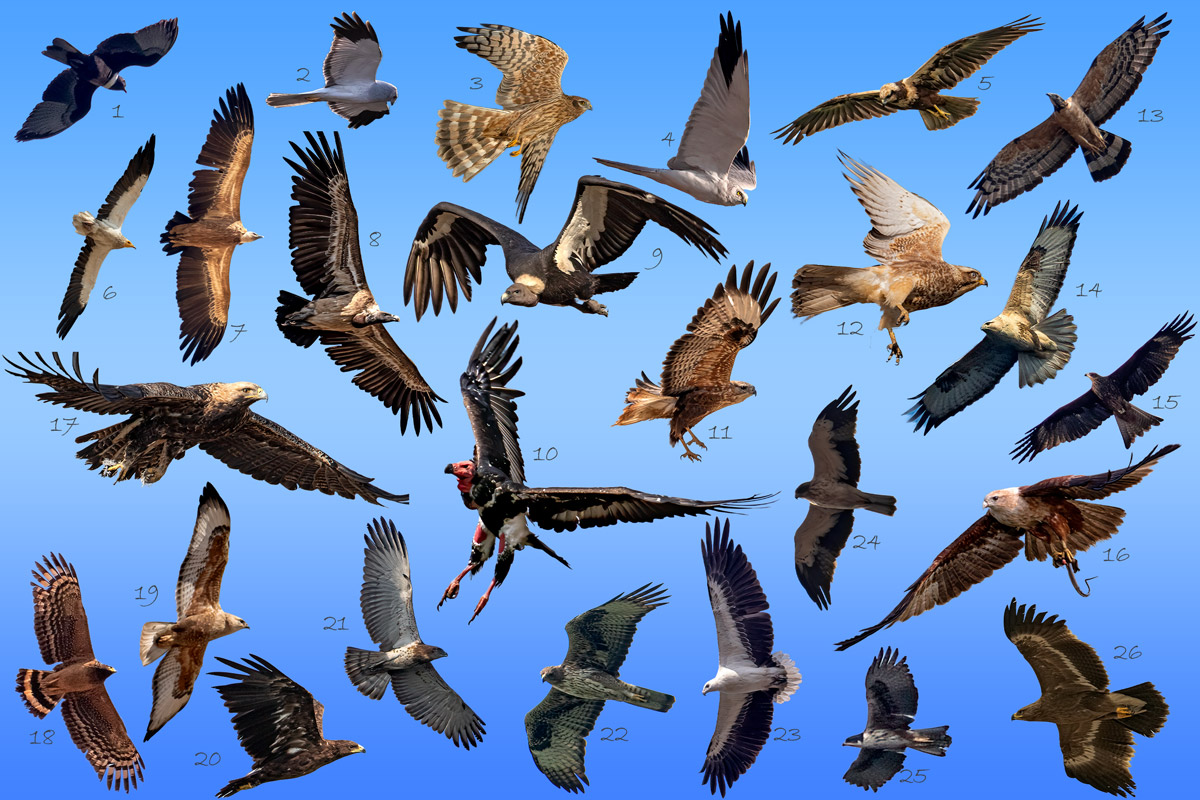Accipitridae – the Raptor Family
Raptors or the Birds-of-Prey are a group of birds having exceptional hunting abilities and adaptations. Here in this collage, I have shown a few raptors from the Accipitridae (Hawks, Eagles, Kites, Vultures) family.
Some of the general features of this group are:
- They have sharp, curved beaks well suited for tearing flesh
- Strong and Powerful talons that enable them to grasp and hold onto their prey
- Their keen eyesight allows them to spot prey from great distances. Not just that, the high density of photoreceptor cells in their eyes enables them to detect the smallest of the movement
- They have special adaptations for flight. Their broad wings allow them to soar effortlessly. Besides that, they can identify the thermal air currents (these are columns of warm air created when sunlight heats the Earth's surface) and use them to gain flying altitude with minimal effort.
- The subfamilies within Accipitridae have adapted different hunting techniques (suitable to their species and habitat). Some are skilled aerial hunters (eagles), some engage in low-level flights (harriers), and the vultures specialize in feeding on the carrion
- They usually build large and sturdy nests using sticks and other materials. The locations could be trees, cliffs, or the ground
- The majority of its members are migratory and do undertake long-distance journeys
- From the overall ecosystem point of view, they play the role of the top predators. They help control the population of prey species, contributing to the balance of the food chain. Their conservation is essential for maintaining the healthy ecosystem
- In most of the species, the females are larger (and weigh more too) than the males
Now let’s look at some of the sub-families belonging to this group
All birds belonging to this family are divided into 13 sub-families but in this collage, I have only included the following seven:
- Perninae (Honey-buzzards, cuckoo-hawks, bazas)
- Circinae (Harriers) - Generally fly low over open ground
- Gypaetinae (vultures and harrier-hawks) - Are not closely related to the vulture group, but closer to the Serpent Eagles
- Aegypiinae (Old World Vultures)
- Buteoninae (Buteonine hawks including milvine kites and sea eagles)
- Circaetinae (Serpent Eagles)
- Aquilinae (Booted Eagles)

Let’s look at it in a little more detail.
Subfamily: Perninae
These are medium-sized birds and are generally from the warmer regions. They feed largely on insects. Among them, the Honey-buzzards feed on the wasp larvae. Some of them are also reptile hunters.
I have included two Genus from this family (there are a total of 7 Genus under this sub-family).
One noticeable thing about these 2 genera (and possibly others, but not sure of that) is, their nostrils are like “slits”. Most other raptors have round nostrils instead. One possible reason could be to avoid bees getting inside as these birds feed on bees.
Genus: Aviceda
The genus name is derived from Latin (avis = bird, cida = killer). The Aviceda genus is widely distributed from Australia to Southern Asia and across Africa. They are also referred to as Cuckoo-Hawks. All bazas do have a prominent crest. They have two tooth-like indentations on the edge of the upper bill.
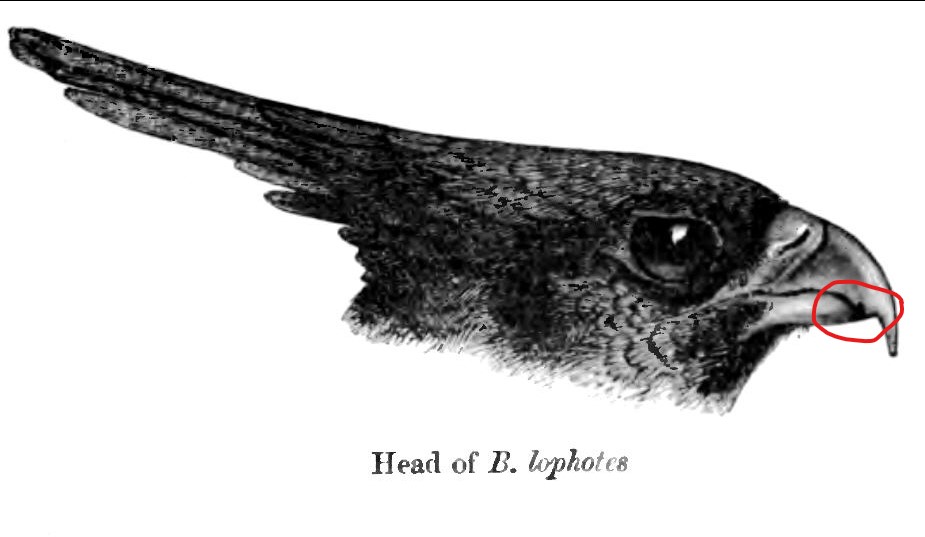
1) Black Baza (Aviceda leuphotes)
They prefer the foothill and lowland forest at their breeding ground but can be found in more open habitats at migration grounds. Overall black coloration with thick white breast-band.
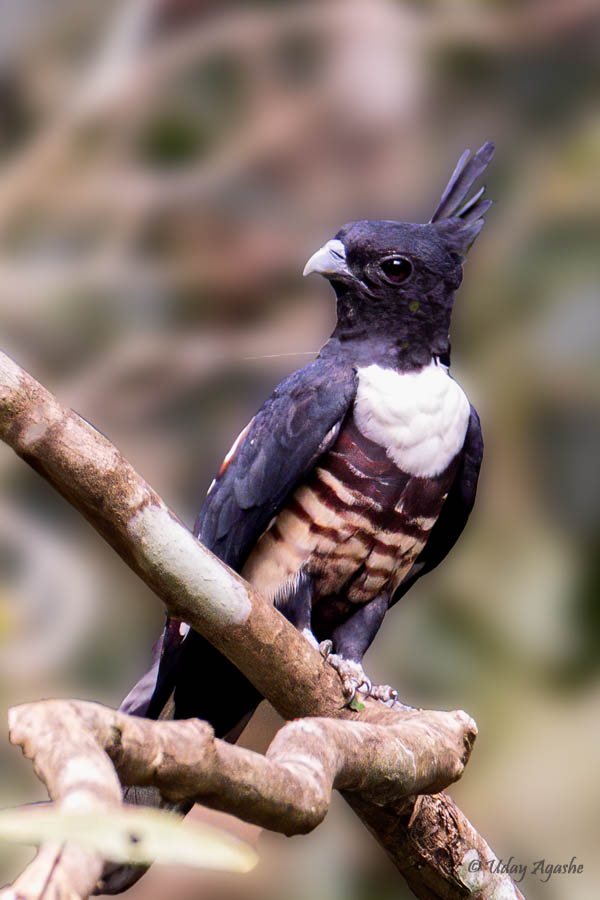

Genus:Pernis (Honey Buzzards)
The genus name is derived from Ancient Greek “pernes”, a term used by Aristotle for a bird of prey. More commonly known as the Honey Buzzards. They breed in temperate regions and specialize in feeding on wasps and bee larvae. Some of the members have plumage that mimics the juveniles of other stronger birds (like common buzzards or hawk-eagles.. they have stronger bills and talons), this helps them avoid being attacked by larger raptors.
13) Oriental Honey Buzzard (Pernis ptilorhynchus)
Also called the Crested Honey Buzzard. Their specialized adaptation includes an elongated head for foraging on underground nests and a groove in the tongue for feeding on honey. The males have dark eyes whereas in females it is yellow.
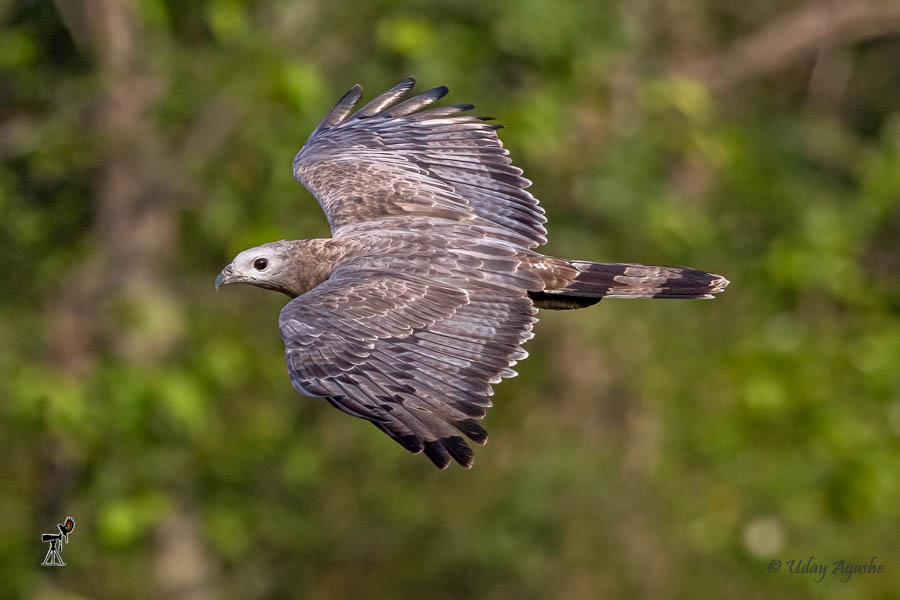

Subfamily: Circinae (Harriers)
The specialty of raptors in this subfamily is, they prefer to hunt by flying low over open grounds/grasslands. And there is only one genus under this subfamily.
Genus- Circus
The word “circus” is derived from the ancient Greek “Kirkos (circle)”. It refers to the bird of prey with its circling flights, possibly by looking at Hen harrier.
These harriers feed on small mammals, reptiles, or birds. They are believed to have been diversified from their ancestors after the expansion of grasslands which is about 6 to 8 million years ago (mya). That is the late Miocene and Pliocene eras. They have adapted to this habitat by way of long wings, long narrow-tail, and slow & low flight.
2) Hen Harrier (Circus cyaneus)
Gets the name from its habit of praying on the fowls. It is one of the few raptors known to practice polygyny (one male partnering with multiple females). Their nest is built on the ground or a mound of dirt or vegetation. When incubating eggs, the female sits on the nest while the male hunts and brings food to her and the chicks.

3) Montagu's Harrier (Circus pygargus)
Another migratory harrier gets its name from British Naturalist (George Montagu). Like most other harriers, they also show Sexual dimorphism. Compared with other harriers this species has characteristic black bands along the secondaries, both above and below the wing, and rusty streaks on the belly and flanks (males). Has a very graceful flight. It is deceptively small, though it appears larger because of its large wing surface, which gives it a typically buoyant flight.
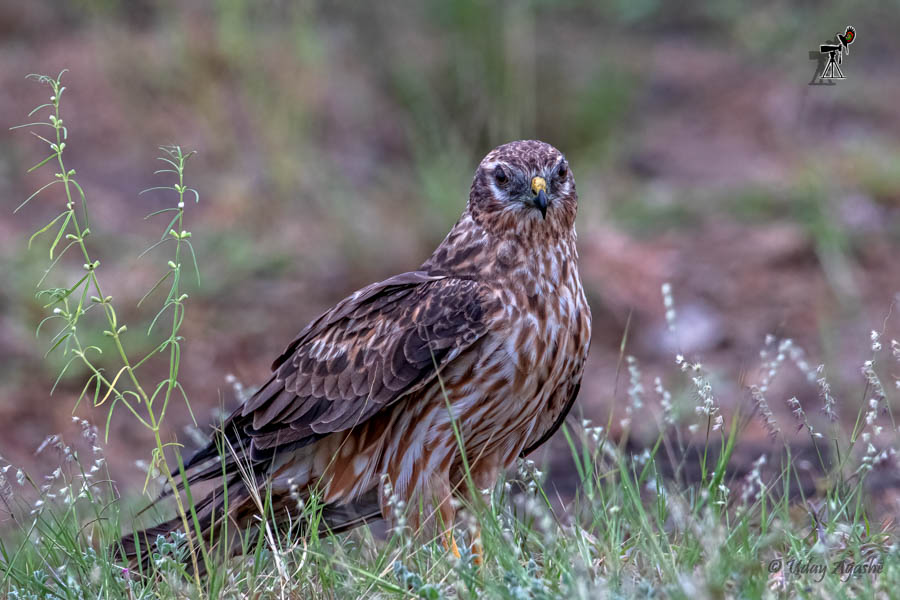
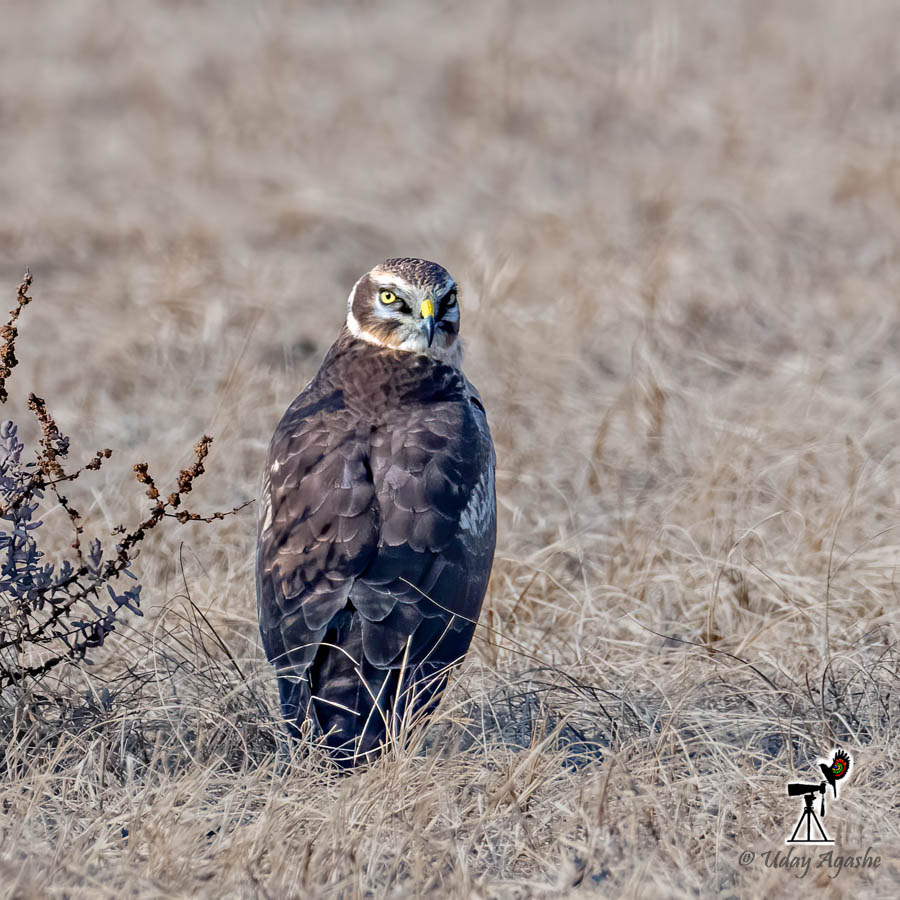
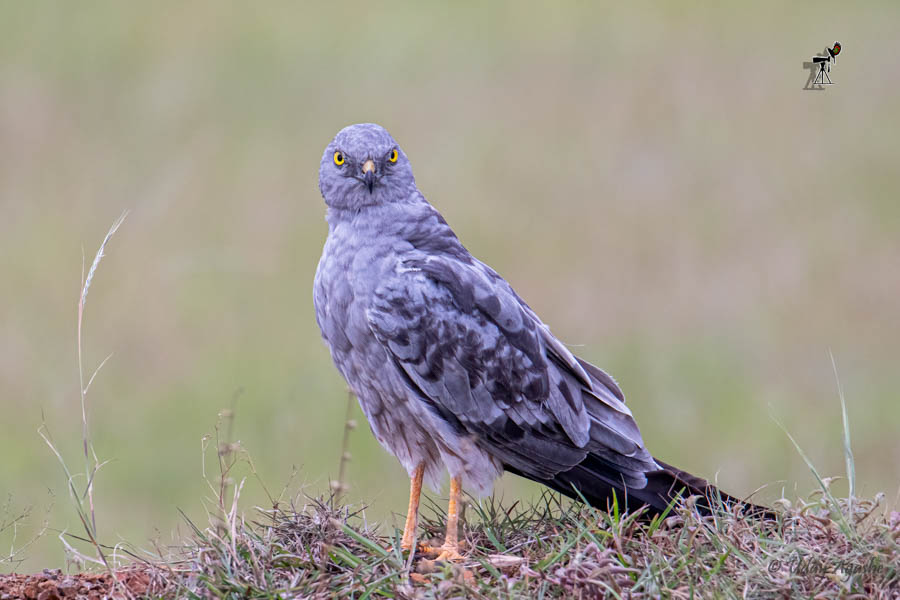
4) Pallid Harrier (Circus macrourus)
This species is under “Near Threatened” category. It breeds in southern parts of eastern Europe and central Asia and Iran and winters mainly in India and southeast Asia. They primarily hunt small mammals and birds, surprising them as they drift low over fields and moors. Can also feed on insects, lizards, and frogs.

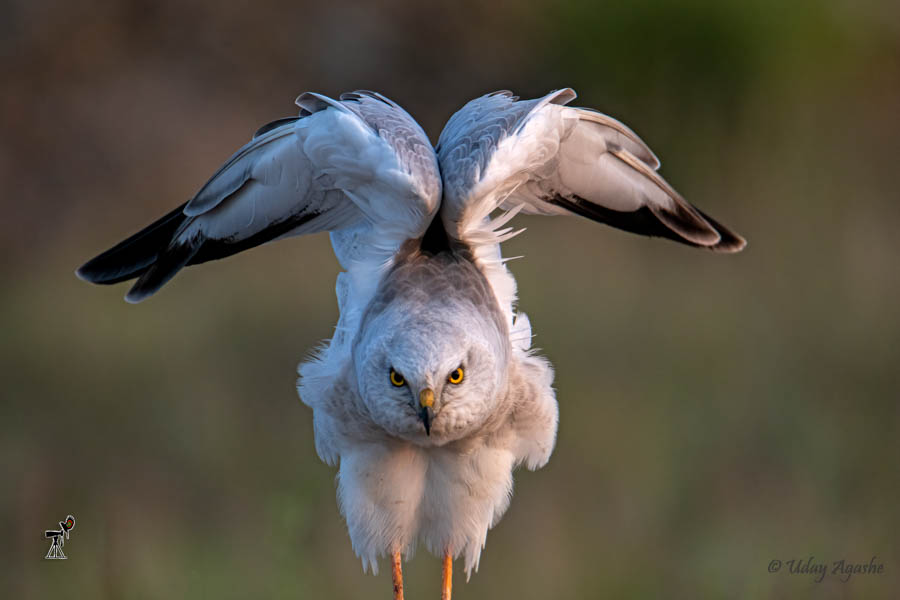
5) Western Marsh Harrier (Circus aeruginosus)
A large harrier that breeds from temperate to subtropical western Eurasia (also the nearby African regions). The male's plumage is mostly a cryptic reddish-brown with lighter yellowish streaks. The female is almost entirely chocolate-brown. As their common name suggests, they prefer the wetland area (marshes). But can be seen on grasslands, and farmlands that border the marshlands.
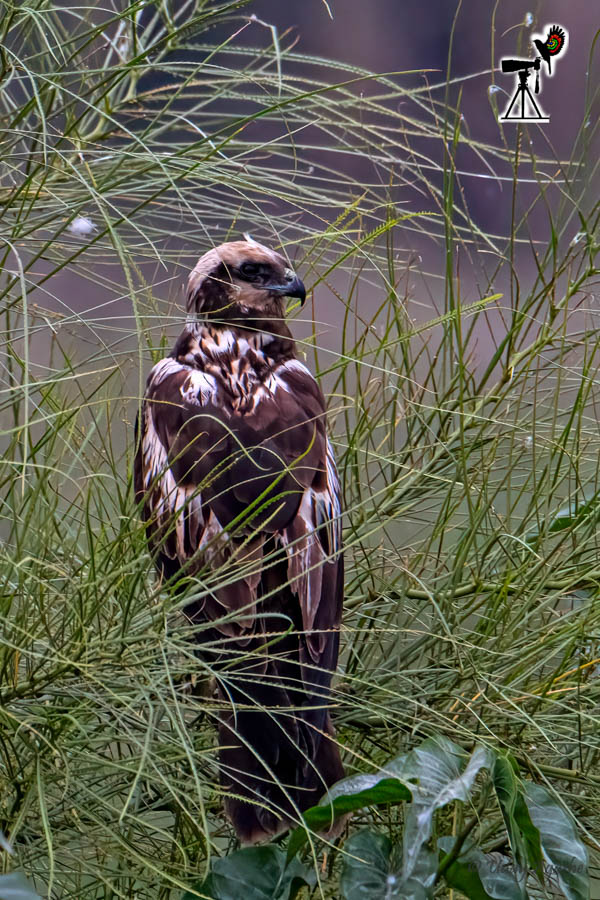

Subfamily: Gypaetinae
This includes some old-world vultures & Harrier-hawks. From the vultures seen in India, only the Bearded Vulture and Egyptian Vultures belong to this subfamily.
Just to clarify, in ornithology terms, OLD-World refers to everything non-America (Afro-EurAsia). This was used when Europe discovered new lands in the form of the American Continent, which became the new world.
Genus - Neophron
This Genus has only one member, the Egyptian Vulture.
6) Egyptian Vulture (Neophron percnopterus)
Among the smaller of the vultures, this is also known as the Pharaoh’s Chicken. It is widely distributed from the Iberian Peninsula (Peninsula in Southwestern Europe) and North Africa to India. Being a vulture it feeds on carrion but is opportunistic hunters and can prey on small mammals, birds, and reptiles. They even take the eggs of other birds (often tossing large pebbles onto it, to break open). It is unfortunately in the “Endangered” category
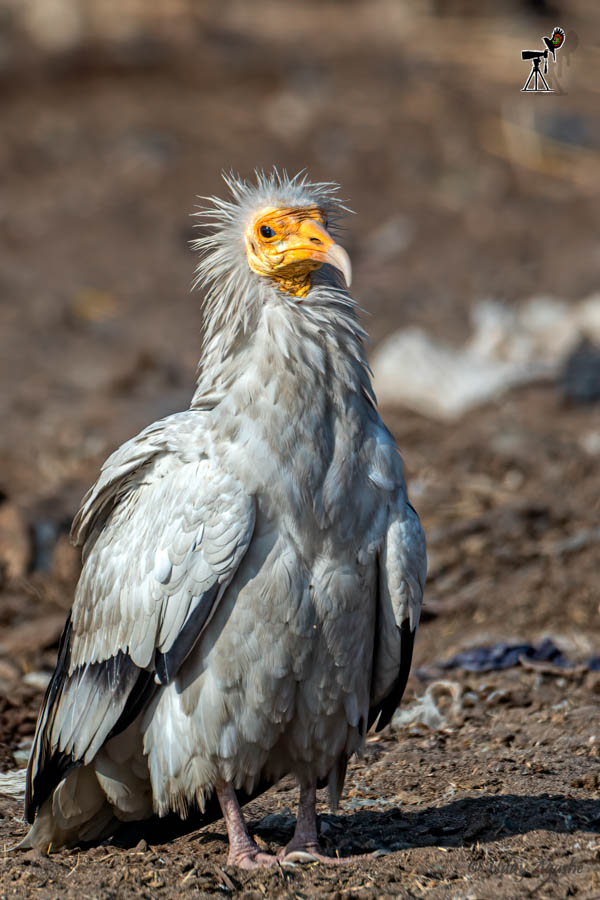
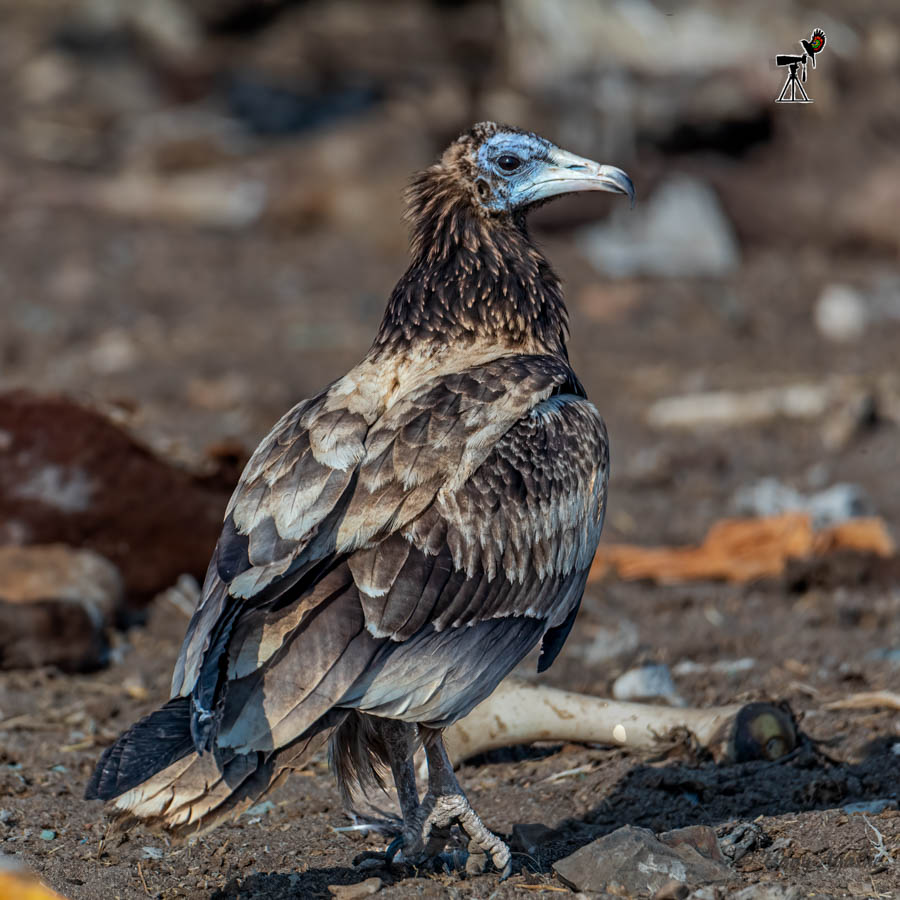
Subfamily: Aegypiinae
Another subfamily includes the old-world vultures. Members of this group can be found throughout Africa, Asia, and Europe. Most of the members are large, have robust bodies, broad wings, and a bare, featherless head. These are generally social and commonly seen in groups (called WAKE). Vultures play an important role in keeping the ecosystem clean.
Their highly acidic digestive system allows them to consume decaying flesh infested with bacteria (like anthrax, botulism, and cholera). It helps keep diseases away by controlling the proliferation of pathogens. By eating the carrion, they even help in recycling the nutrients which work well for the overall food chain
Diclofenac Poisoning & Vultures: Diclofenac was a common veterinary medicine in the 1980s and 90s (in Asia) that was used as an anti-inflammatory drug. Vultures routinely consumed such carcasses (that was treated with diclofenac). While it is a safe medicine for humans, it has been highly toxic for the vultures, badly damaging their kidneys. This resulted in a rapid decline in vulture numbers
Genus - Gyps
The name comes from the ancient Greek gups meaning vulture. The members of this group are known as the griffon vultures. They have a slim head, a long slender neck, and a ruff around the neck formed by long buoyant feathers. They have six or seven wing feathers, of which the first is the shortest and the fourth the longest. Besides the three species mentioned below, this genus also includes the Himalayan Griffon and Slender-billed Vulture.
7) Eurasian Griffon (Gyps fulvus)
Also known as the Griffon vulture. It is closely related to the White-backed Vulture found in Africa. It is a large bird and the wingspan could stretch to around 9 feet. One of the few vulture species that is still under the “Least concern” category because of its widespread presence. Their nesting colonies are on high cliffs (undisturbed by humans). Humans have used these vultures as models for the study of soaring and thermoregulation. Many other birds, in flight, elevate their heart rate to 16 times their basal rate, whereas the soaring griffons expend only about 2 times their basal rate.


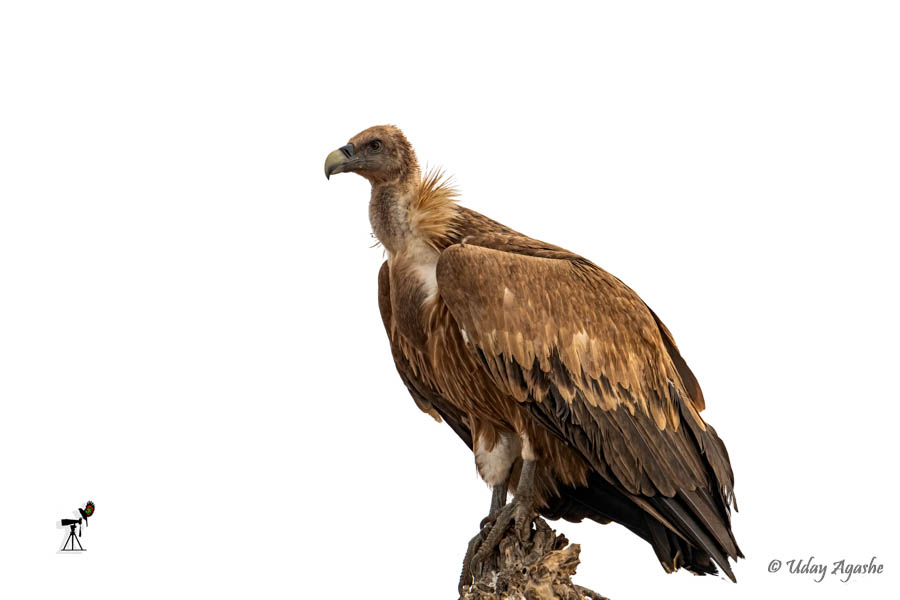
8) Indian Vulture (Gyps indicus)
A species that is “Critically Endangered”. It is a medium-sized and bulky bird. Its body and covert feathers are pale and the flight feathers are darker. This (along with the white-rumped vulture) species has suffered a 90+ percent population decrease in recent decades (diclofenac poisoning). A captive breeding program for these vultures is currently in place.
Vulture Restaurant: to help arrest the population decline of vultures, designated areas in various regions have been earmarked as vulture restaurants. Any livestock carcass from surrounding areas is brought there by the farmer (they get some monetary compensation for getting a diclofenac-free carcass). Vultures get regular food supply there and the farmers get compensated for their dead cattle plus the Environment remains clean
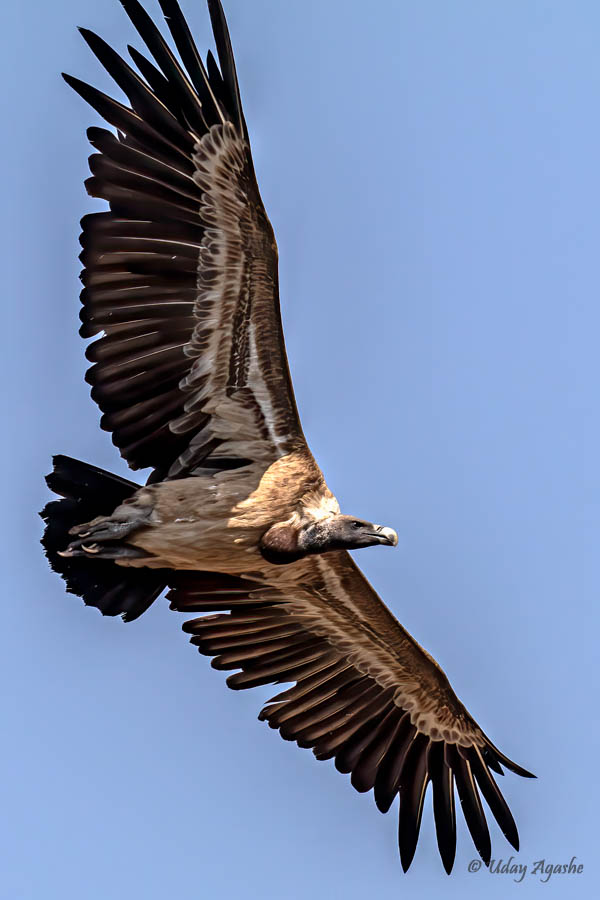
9) White-rumped Vulture (Gyps bengalensis)
Another “Critically Endangered” vulture species. It is native to the South and Southeast Asian region. It is a typical medium-sized vulture, with an unfeathered head and neck, very broad wings, and short tail feathers. Generally have a white neck ruff. The head is pinkish and the bill is silvery with dark ceres.
They build their nest on tall trees often near human habitations and the clutch generally has only one egg. The populations are mostly resident.
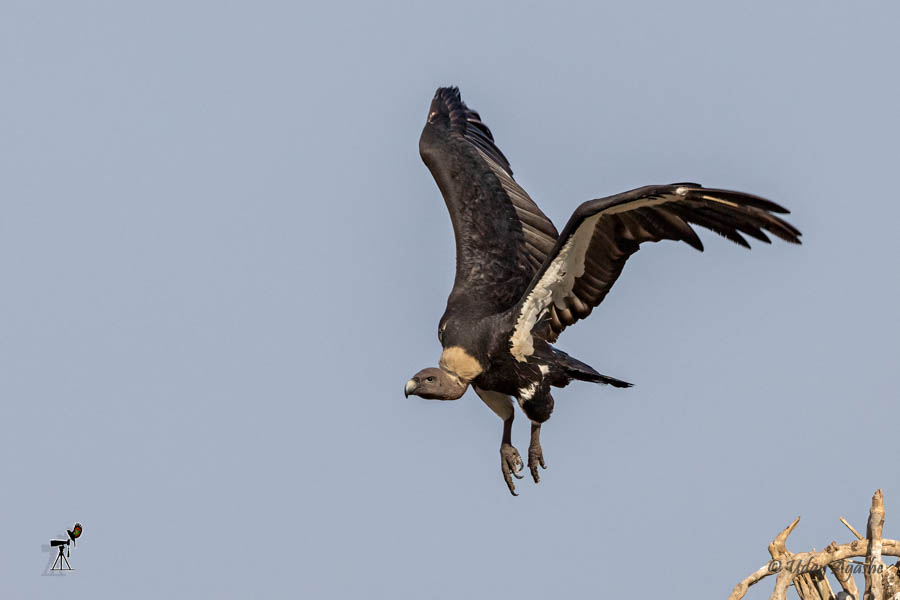

Genus - Sarcogyps
The Red-headed vulture is the only species in India under this Genus.
10) Red-headed vulture (Sarcogyps calvus)
Also known as the King Vulture. A medium-sized vulture that weighs about 5-6 kg and has a wingspan of about 7 to 8 feet. Its red-head makes it very easy to identify it in the wild. Juveniles have paler heads. Iris color differs across sexes. Males have paler iris whereas females have dark brown iris. Like most other vulture species in India, this is also under the “Critically Endangered” category. It was once present in the Indian subcontinent (extending up to Singapore), now restricted mainly to North India.

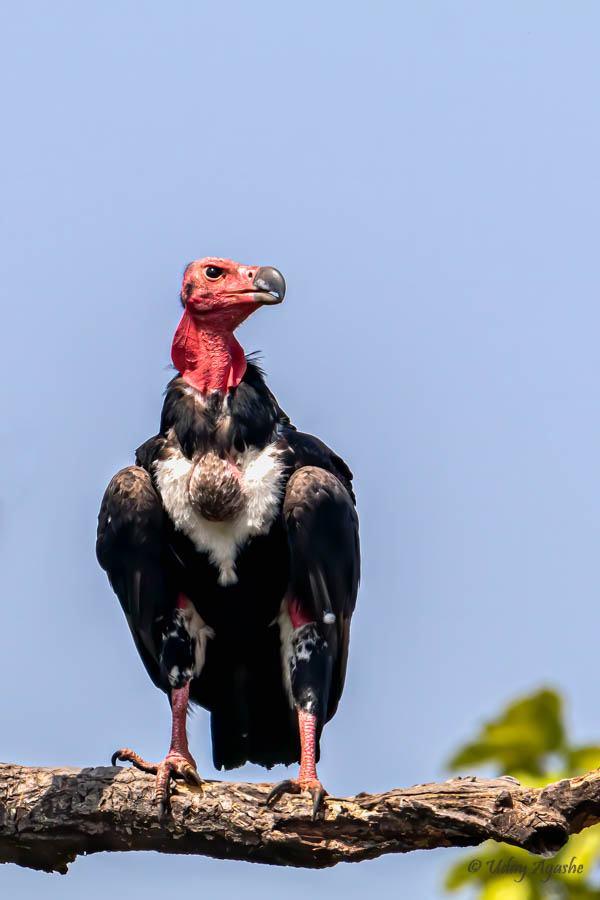
Subfamily: Buteoninae
This is the family of buzzards. It is a large subfamily that includes 55 species and has a lot of diversity among the members with some looking like eagles. Unlike many other sub-families of Accipitridae, this subfamily seems to have emerged out of the Americas (based on fossil records), and even among the current species, 75% of the members are from the Americas. This subfamily also includes the kites.
Genus - Buteo
These are large raptors with robust bodies and broad wings. The Old-world members are mostly called buzzards, whereas, in the New-world, these are Hawks. The Buteo comes from Latin, which means the Common Buzzard. The largest among these is the Upland Buzzard (found in India, but not included in the collage), which has a wingspan of about 5 feet.
All the buteo species are opportunistic and they prey on any small animal as it becomes available. But their preferred food is small mammals (mostly rodents)
11) Long-legged Buzzard (Buteo rufinus)
Common across many parts of Eurasia and North Africa. Although rodents are their primary diet, they can take reptiles, birds, insects, and even carrion at times. Can adapt to various habitats and may build nests on a variety of surfaces like rocks, cliffs, or trees.
These buzzards are slightly sluggish and prefer to perch on vantage points (even on utility poles). It is highly variable in plumage and can have 4 different morphs.
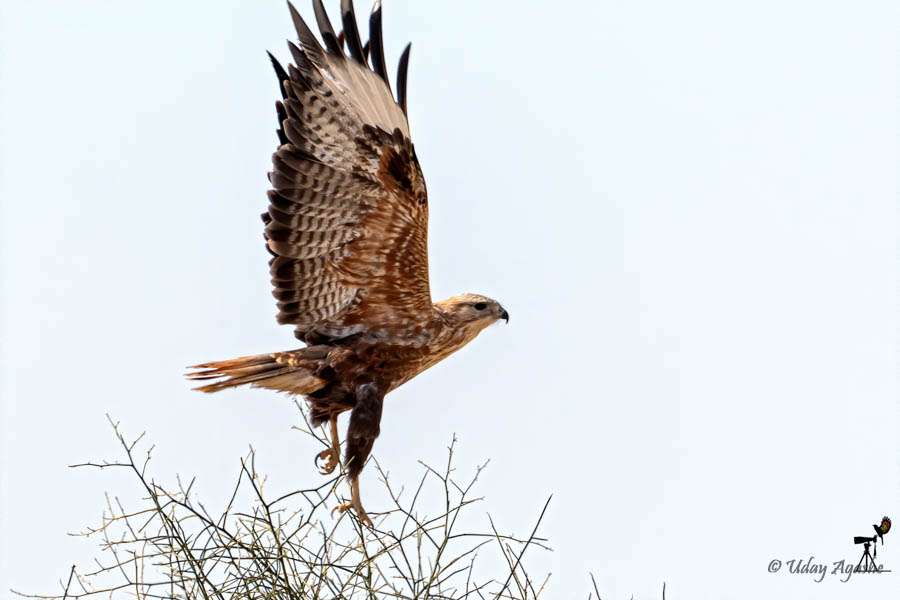
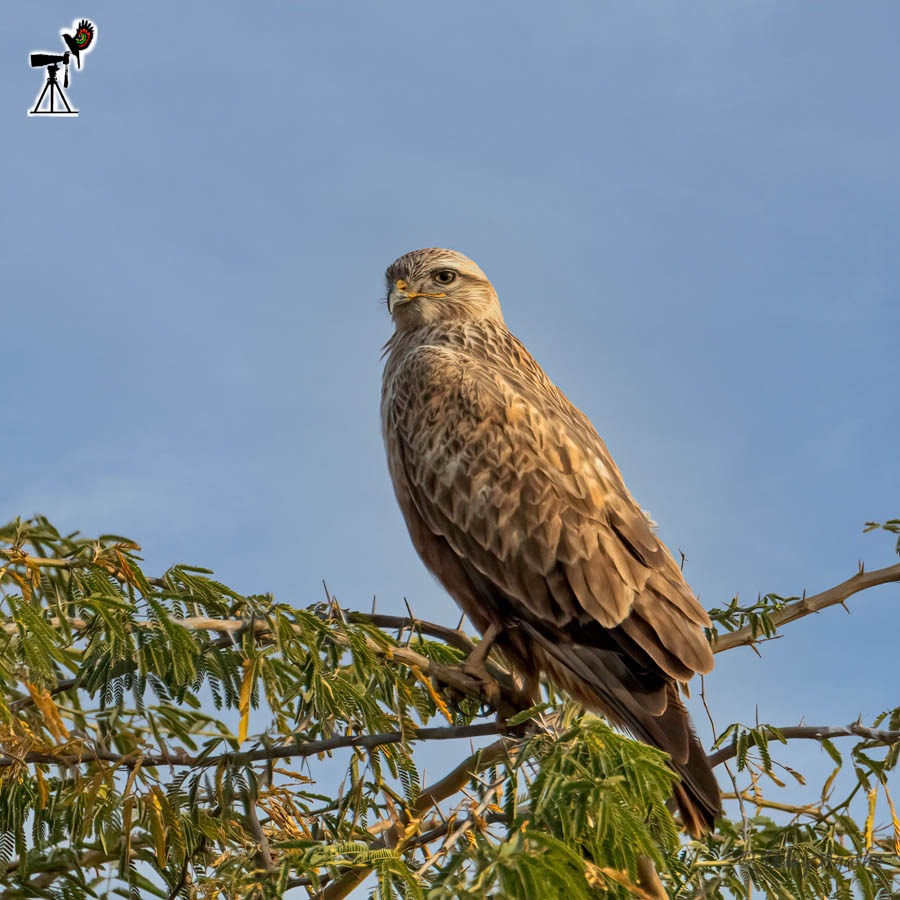
14) Common Buzzard (Buteo buteo)
It is common across most of Europe and much of the Palearctic (as far as Mongolia). It is resident in most of this range. But those breeding in the colder regions do migrate to as far as South Africa. During the winter months, I have seen it in Matheran as well
Their preferred habitat is the interface of woodlands and open grounds. Not seen in the treeless tundra as they need tall trees for perch hunting as well as nesting. But at times, they can also forage on the ground.
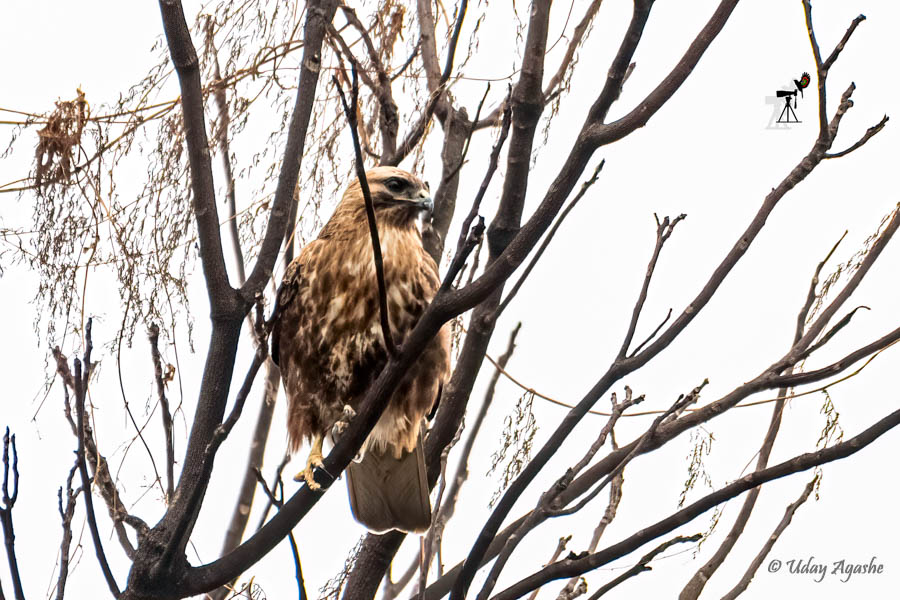
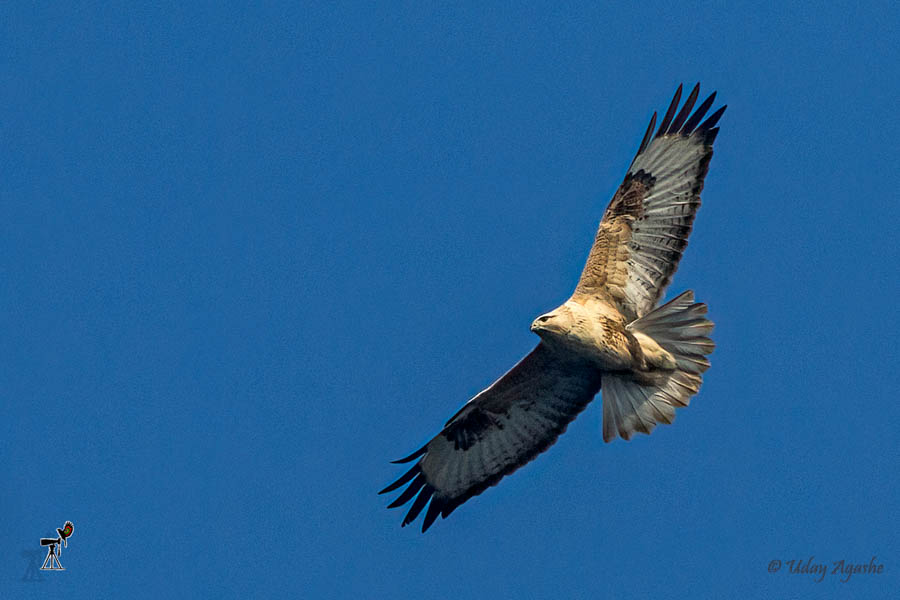
Genus: Butastur
This genus was first introduced in the year 1843 and the White-eyed Byzzard was considered the type species (reference species for the genus). The genus has 4 members out of which only the White-eyed Buzzard can be seen in India. The genus name was a mix of “Buteo+Astur” (Buteo for true buzzards and Astur was the old name for sparrowhawks since it has the characteristics of both)
12) White-eyed Buzzard (Butastur teesa)
The “teesa” part in its scientific name is based on its Hindi name. A medium-sized hawk can be easily identified because of the white iris, white throat, and mesial stripe (a line between throat and mouth). The juveniles do not have the white iris though. Its dark wing tips are clearly visible while in flight.
It is widely distributed across South Asia and is mostly resident. Seen up to 1000 meters in the Himalayas and is absent in Sri Lanka and Andamans. They usually prefer the dry, open forest or cultivation.
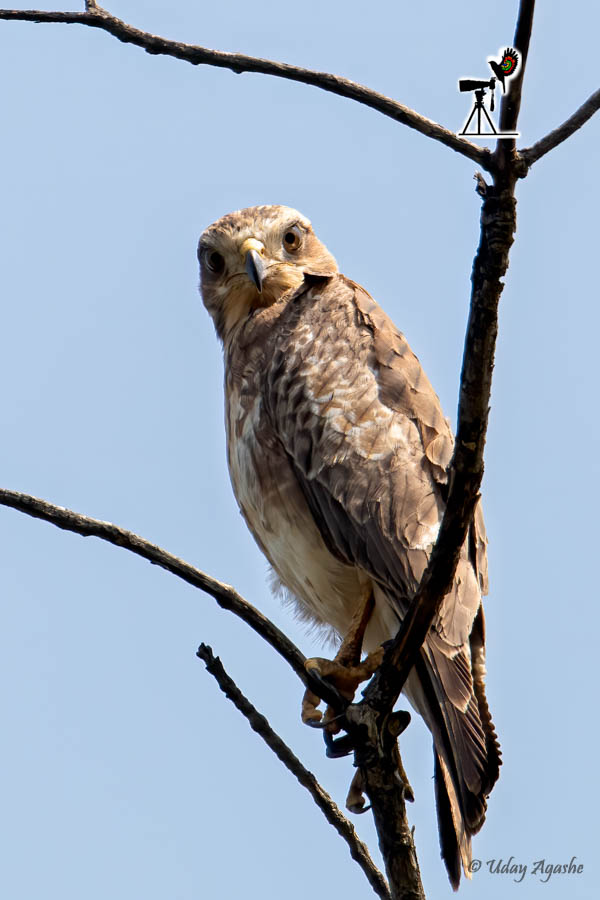

Genus: Milvus
These are medium-sized birds of prey and include only 3 varieties of Kites.
15) Black kite (Milvus migrans)
It is thought to be the world's most abundant species of Accipitridae. It is a very common raptor seen in our city skies these days. Unlike others in this group, black kites are opportunistic hunters and are more likely to scavenge. They spend a lot of time soaring and gliding in thermals in search of food. Their angled wings and forked tail make them easy to identify while in flight.
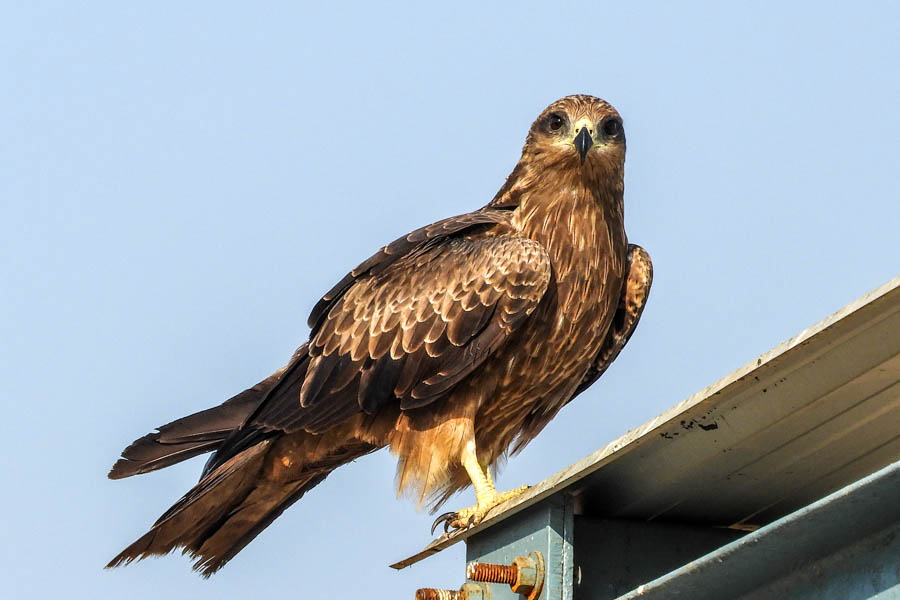

Genus: Haliastur
A small genus includes only 2 species of kites (Brahminy and Whistling kite). Both are medium-sized birds with small heads, relatively short& wide wings, a rounded tail, and short but strong legs & toes.
16) Brahminy Kite (Haliastur indus)
Also sometimes referred to as Red-backed Sea-eagle. It was first described in 1760 by a French zoologist who had observed it in Pondicherry. This kite has a distinctive plumage (overall chestnut except for the white head and breast). Juveniles are more brown. These kites are mainly seen in the plains but are sometimes seen above 5000 m in the Himalayan region.
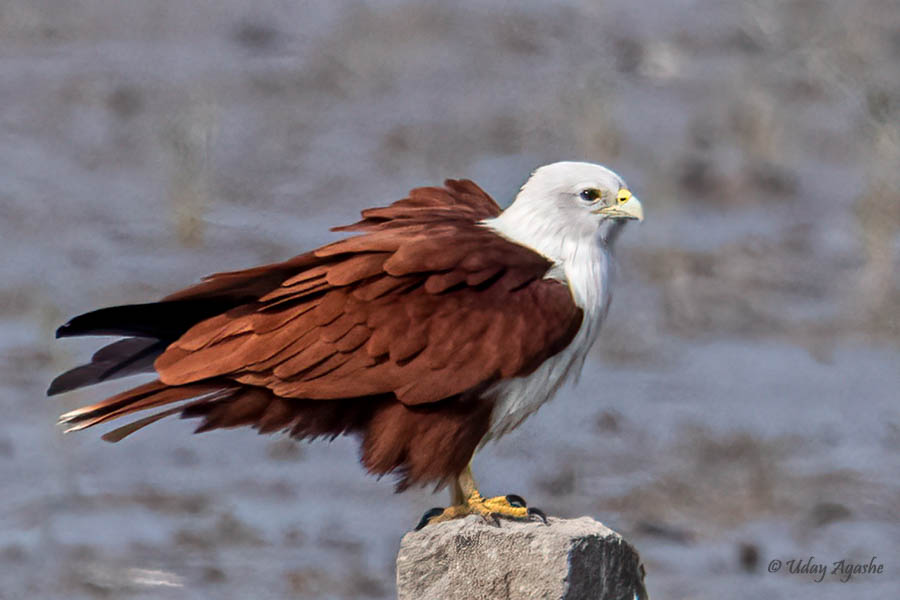


Genus: Haliaeetus
This is the group of sea eagles or fish eagles. It includes a total of 10 species out of which four can be seen in India (White-bellied Sea-eagle, and Grey-headed, Lesser, and Pallas’ Fish Eagles).
This is possibly the oldest genera of living birds. Fossil data from 33 Mya (Million years ago) has similarities with the modern sea eagle. The genus was present in the middle Miocene (12-16 Mya) with certainty.
23) White-bellied Sea Eagle (Icthyophaga leucogaster)
A distinctive bird, the adult white-bellied sea eagle has a white head, breast, under-wing coverts, and tail. The upper parts are grey. These eagles are resident in India and Sri Lanka (also southeast Asia to Australia). They are generally seen on the coasts and major waterways. They breed and hunt near water and naturally, the majority of their diet is fish.
The white-bellied sea eagle is revered by indigenous people in many parts of Australia and is the subject of various folk tales throughout its range.
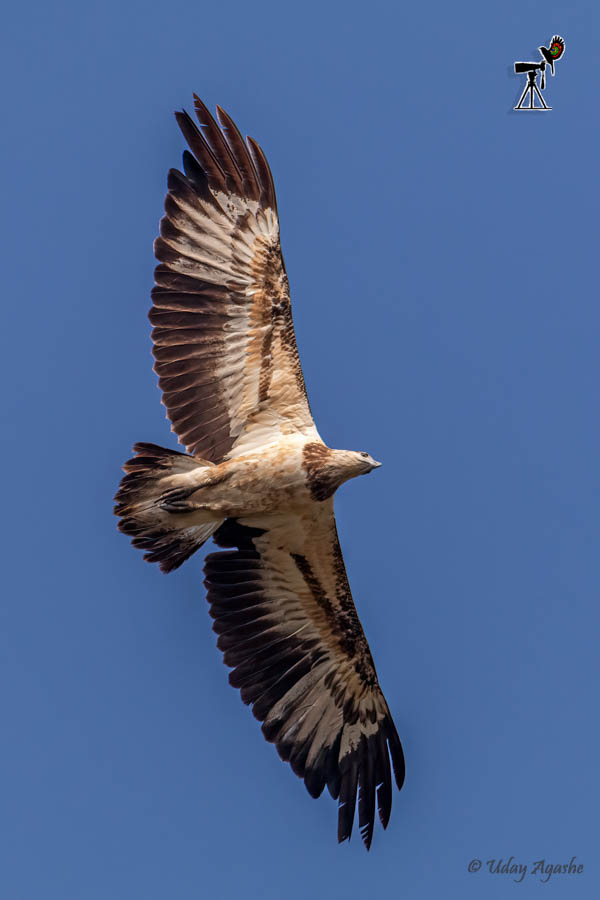

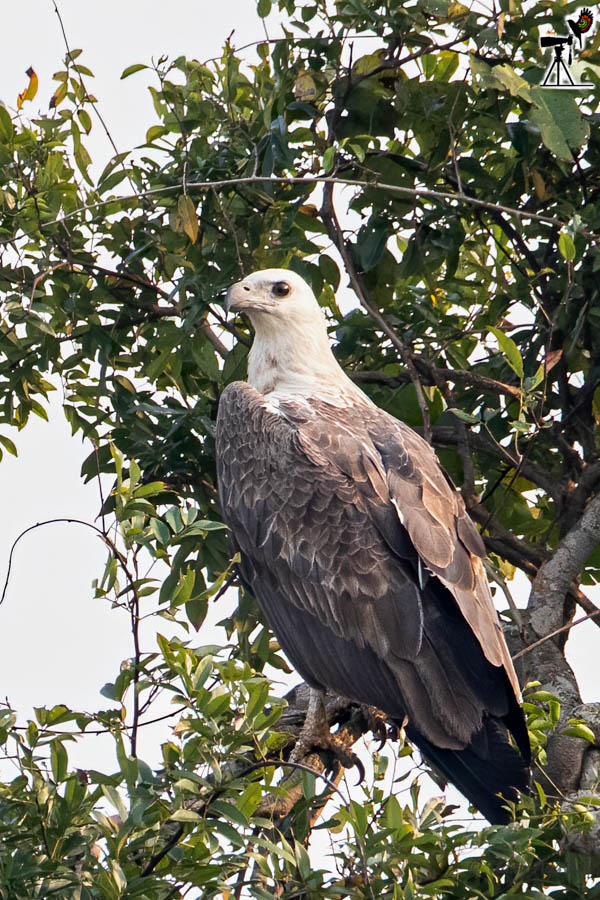
Subfamily: Circaetinae
This is the family of the serpent eagles. These are medium to large, broad-winged birds that specialize in feeding on snakes and other reptiles (hence the common name of the species in this group). Only the bateleur (found in Africa) is an exception as that is a more generalized hunter. They have extremely keen eyesight that enables them to spot potential prey from a distance
Genus: Spilornis
These medium-sized hunters have dark crowns and bright yellow eyes. They are commonly seen in the forests of South Asia and are known as serpent eagles. There are a total of 6 species under this genus out of which 3 are found in India (Crested, Andaman & Great-Nicobar Serpent Eagles).
18) Crested Serpent Eagle (Spilornis cheela)
This eagle is widespread across the Indian Subcontinent, Southeast Asia, and East Asia. Overall dark brown with rounded wings and a short tail. These are forest hunters and snakes & lizards are their favorite food. It can occasionally feed on small birds, amphibians, mammals, fishes, termites, and large earthworms.
A radio-telemetric study of the species in Taiwan found that they spend 98% of the day perched. They appear to use a sit-and-wait foraging strategy and they usually find prey in the morning hours.
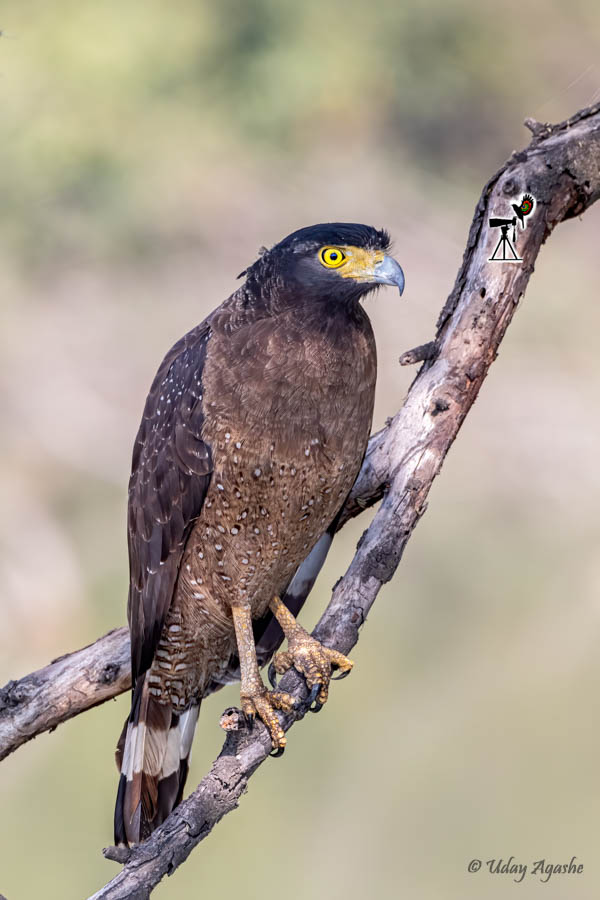
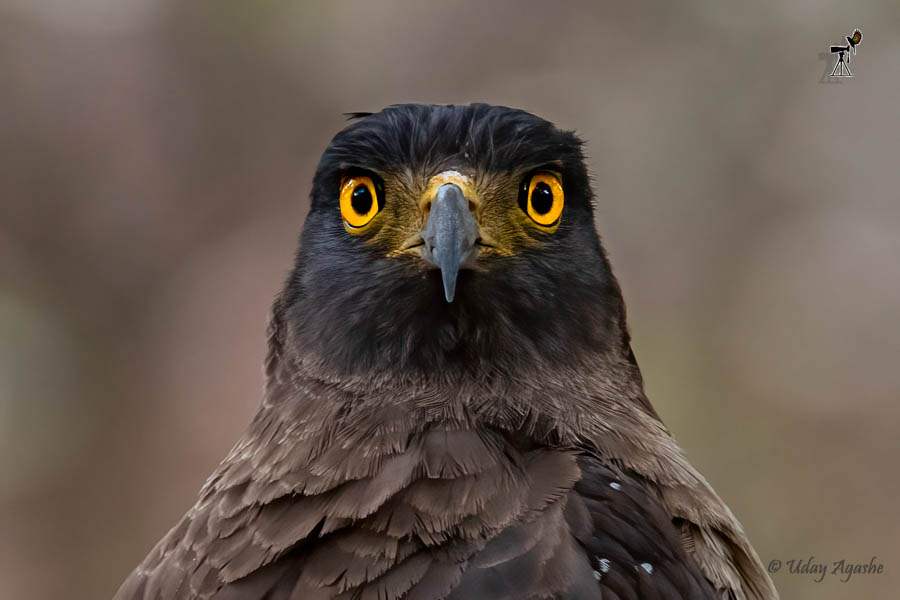
Genus: Circaetus
All 6 members of this group are called snake eagles out of which only the short-toed snake eagle is seen in India. The genus was first introduced in the year 1816. The name is derived from the Ancient Greek Kirkos (type of hawk) & “aetos” (eagle).
These eagles are found in open habitats (cultivations and savanna) but require tall trees to build nests.
21) Short-toed Snake-eagle (Circaetus gallicus)
This was first described in the year 1788 and it was then put in the group of falcons (Falco gallucis was the name then). It is known to spend more time on the wings compared to other members of this genus. It soars over hilltops on updraughts (thermals) and does much of the hunting from the height of 500 meters. It can also hover over like the kestrels.
Snakes/reptiles are their primary prey and sometimes they become entangled with large snakes and battle it out on the ground.
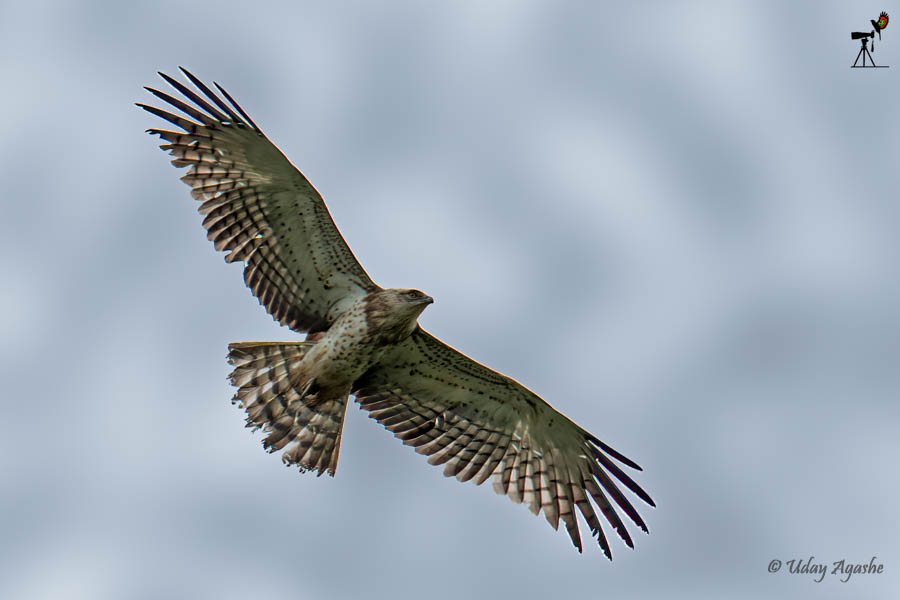
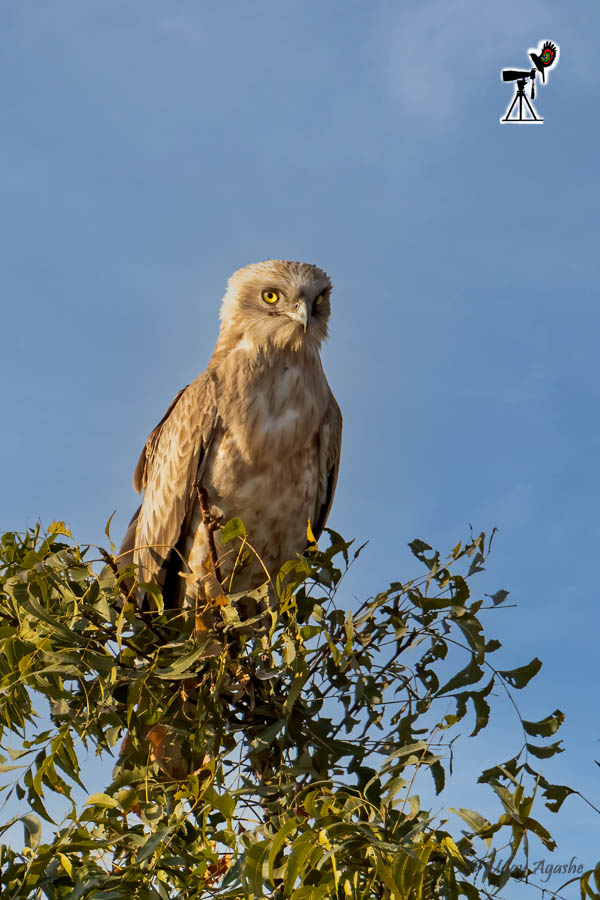
Subfamily: Aquilinae
A common name used for this subfamily is booted eagles (although one specific specie is also named the same). It refers to their well-feathered legs. Based on the DNA studies this group seems to have been separated from the other Accipitridae members over millions of years. This group has a wide size variation from pygmy eagle (weighs about ½ kg) to Martial Eagle (weighs about 4 kg). Up to the 16th century, this group had a huge member, the Haast’s eagle from New Zealand (here the females weighed 14+ kgs and measured up to 55 inches long).
Genus: Aquila
The genus of true Eagles. Even the Latin name refers to the same. This group has 11 species in it (5 of them can be seen in India).
17) Eastern Imperial Eagle (Aquila heliaca)
It is a large bird of prey that breeds in Europe and Central Asia. Most populations are migratory and winter-migrate to Africa and Asia. Commonly seen in India during the winter months. It is the darkest species in its genus. This is an opportunistic predator that preys on smallish mammals but can also take birds, reptiles, and even carrion when available. Their nests are located in large, mature trees and the parents raise max two fledglings. Their global population is small (and declining) resulting in the status “Vulnerable”.

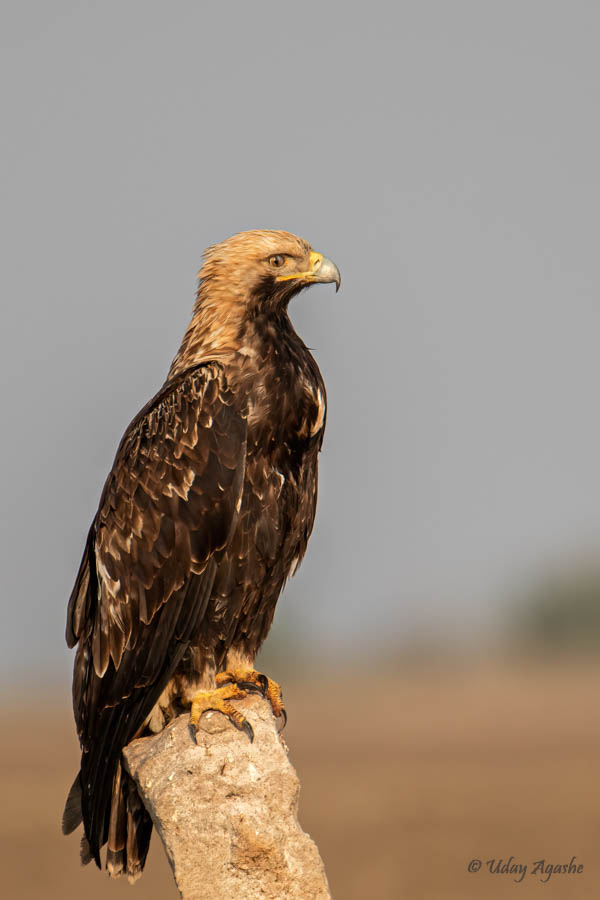
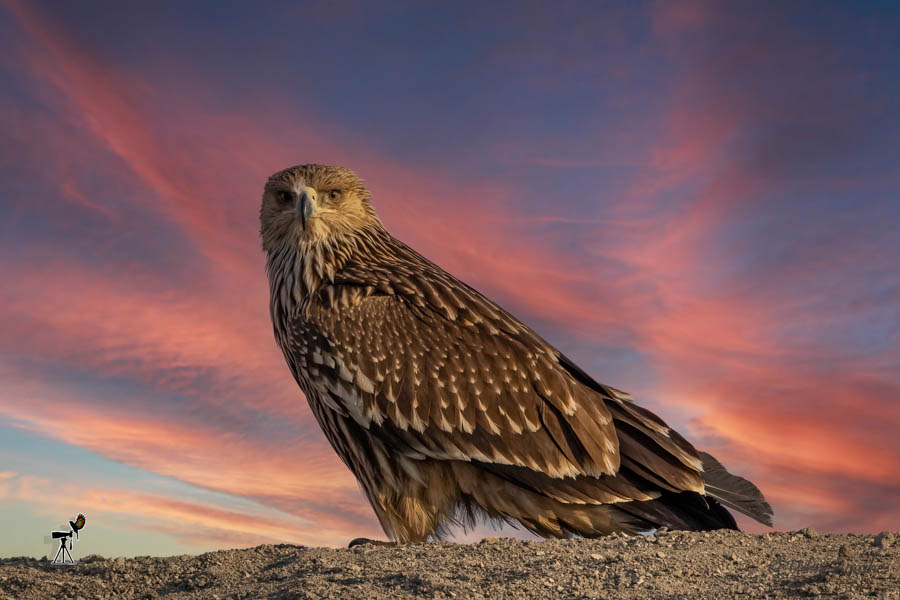
19) Tawny Eagle (Aquila rapax)
Tawny eagles have an extensive but discontinuous breeding range from much of the African continent to the Indian subcontinent. Its preferred habitat includes semideserts, desert steppe, and savanna plains (but it does need at least a few tall trees). They are resident throughout the range. It is perhaps the most opportunistic of the family. They often scavenge or even engage in kleptoparasitism (stealing food from others). But they are also bold predators and often hunt relatively large prey. Due to their declining numbers, they are categorized as “Vulnerable”.
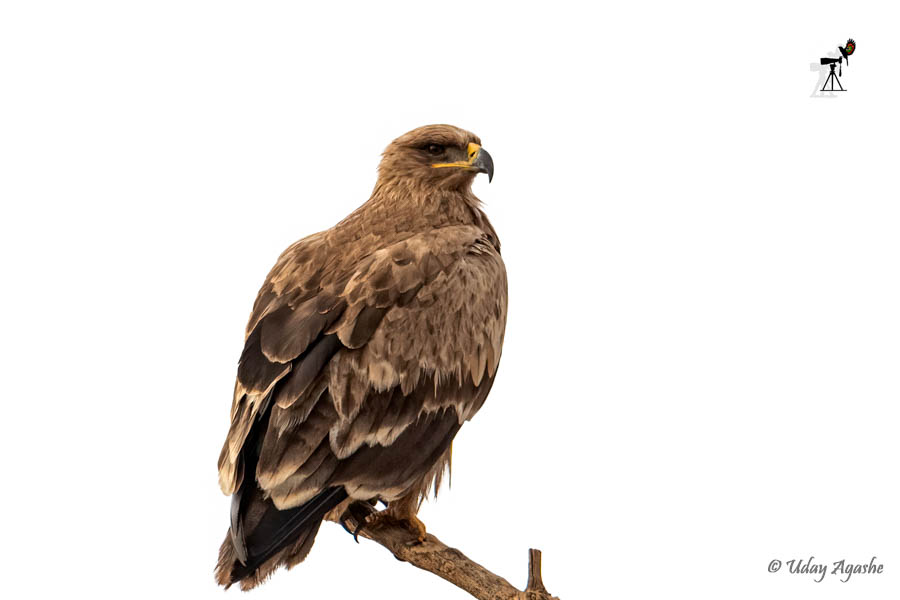
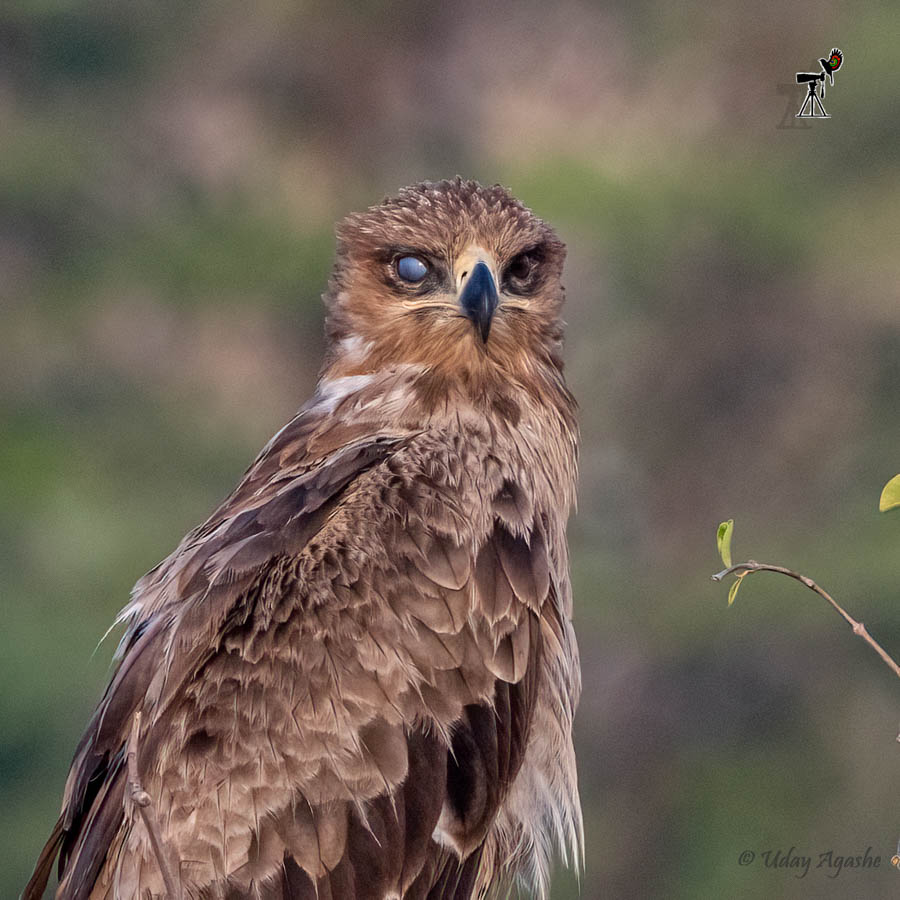
22) Bonelli's Eagle (Aquila fasciata)
Another medium-sized eagle breeds from Southern Europe, Africa, and across the Indian Subcontinent to Indonesia. Usually a resident breeder (does not migrate). Often seen in hilly, mountainous habitats (from sea level up to 1500 m). Like most raptors, it mainly lives solitarily or in a breeding pair.
The Bonelli’s eagle mostly takes the prey from on or near the ground but some are snatched even from the bushes or even water.
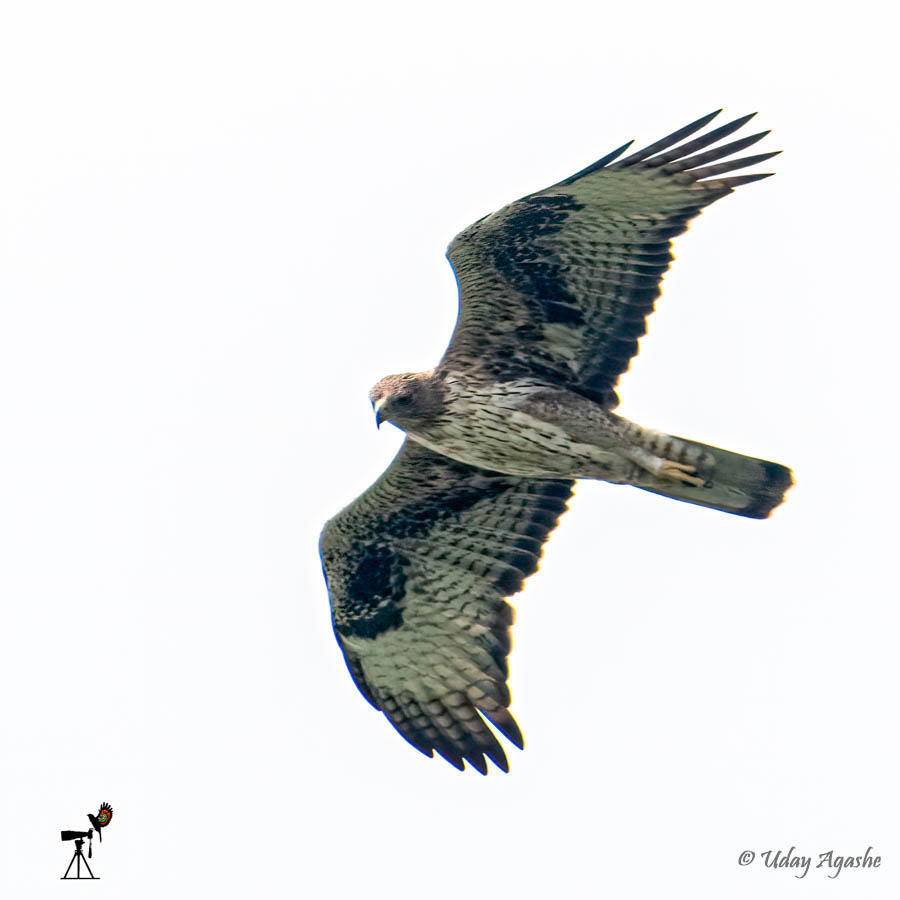
26) Steppe Eagle (Aquila nipalensis)
The word “nipalensis” in its name, is from the fact that the type specimen was collected from Nepal (possibly during winter migration).
It is a large bird of prey with peculiar feathery legs (characteristic of booted eagles). It is a specialized predator of ground squirrels on their breeding grounds. But do take other prey when this stable food is limited (or on the migration grounds).
Their declining numbers (hunting in their primary breeding habitat in Kazakhstan, electrocution) have resulted in their status being an “Endangered” species. The eagle though has the distinction of being a National Bird (as well as seen on their flags) of Kazakhstan and Egypt.

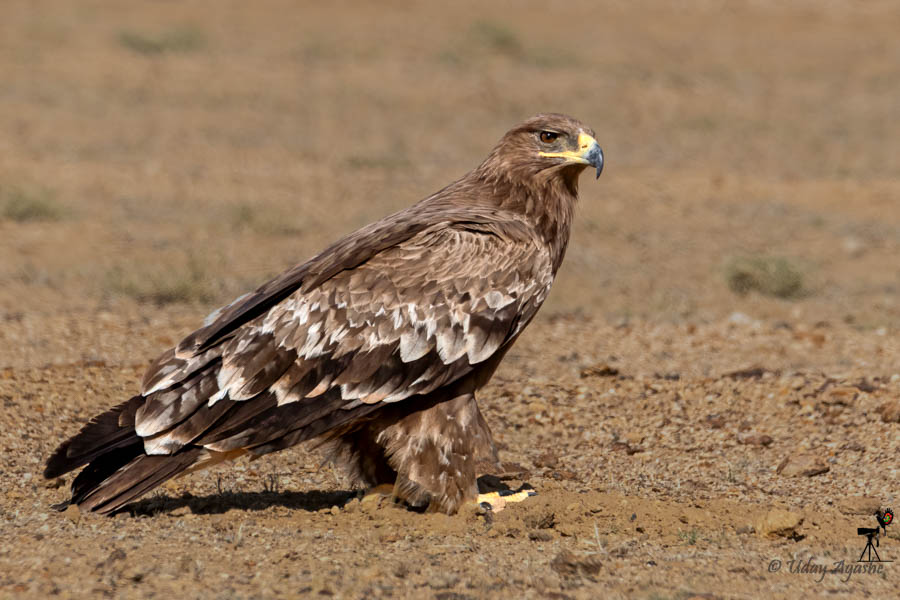

Genus: Clanga
This includes the group of three Spotted Eagle species (Greater-spotted. Lesser-spotted, and Indian-spotted). The name comes from the Ancient Greek “klangos” meaning Eagle.
20) Greater-spotted eagle (Clanga clanga)
These eagles breed in many parts of Europe but some breeding records are also from India (Rajasthan, Gujarat, even up to Maharashtra sometimes) in the past. During winter they migrate to the Mediterranean region, Middle-east, and Indomalayan region. They generally prefer wetter habitats (compared to other eagles).
These eagles generally feed on small mammals (rodents), frogs, and a variety of small birds (especially vulnerable water birds). They are aerial foragers, gliding from concealed perches to catch the prey.

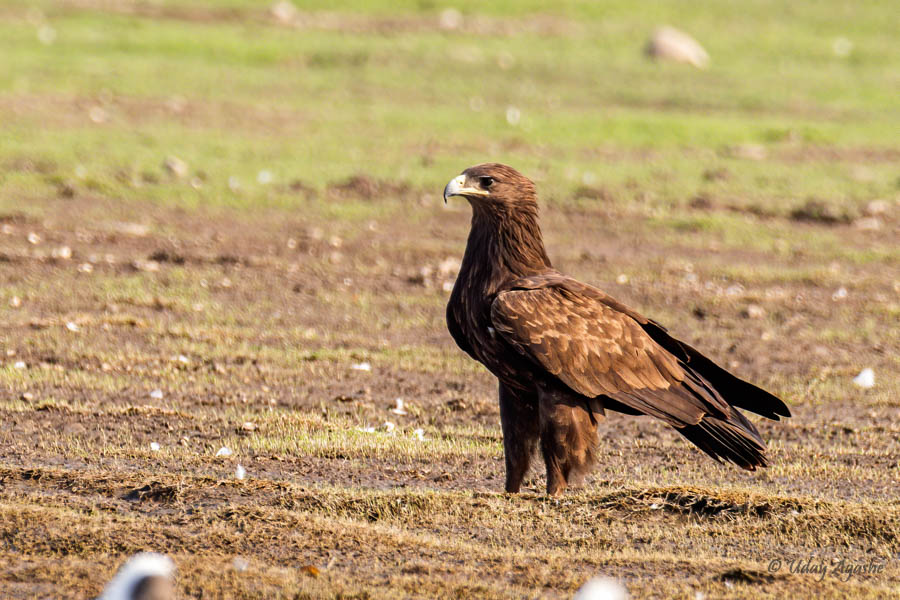
Genus: Hieraaetus
This is a group of small eagles or hawk eagles. This includes a total of five species out of which only one (booted eagle) can be seen in India
24) Booted Eagle (Hieraaetus pennatus)
A medium-sized eagle that breeds in the Palearctic and Southern Asia. During winter they migrate to Africa and Asia.
They generally fly at relatively low heights and hunt on wings. They hunt with wings folded in and feet extended out. Mammals, reptiles, and birds are all part of their diet.
Their nests are built from sticks lined with green leaves. The incubation period is about 45 days and during that period as well as during raising the young ones, the female remains in the nest, and the male provides the food.
In flight, their wings show white marks on the shoulders giving the appearance of “landing lights” or “headlights”.
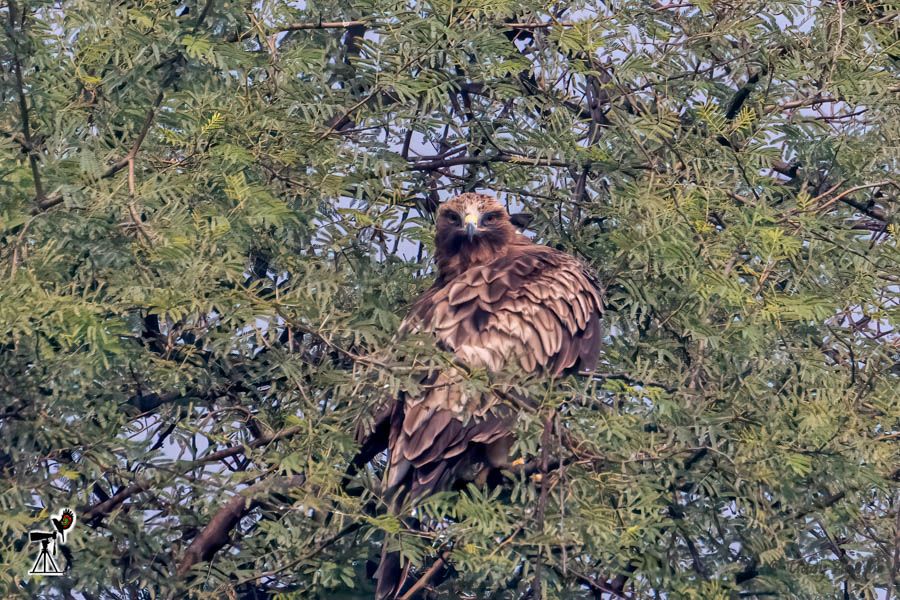
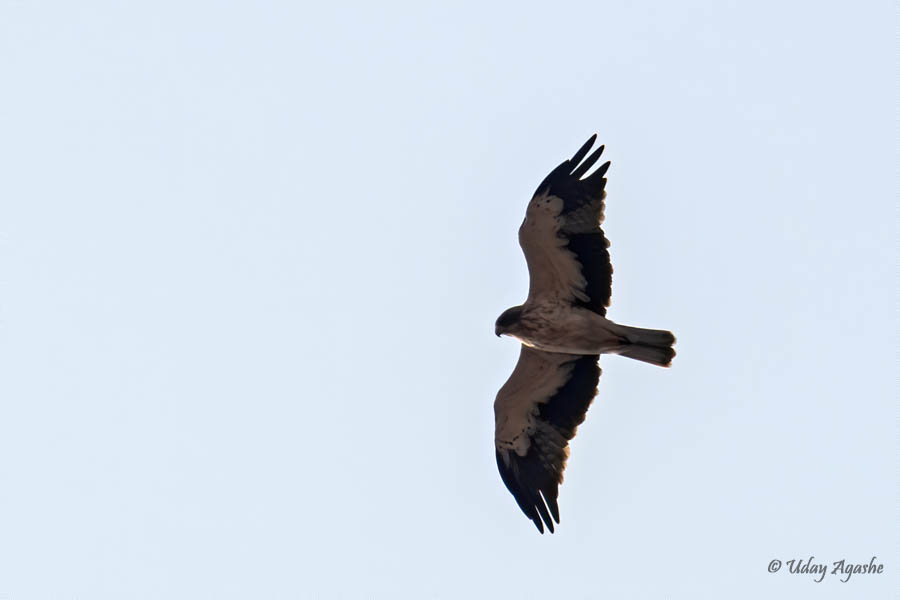
Genus: Lophotriorchis
The genus has only one member, the Rufous-bellied Eagle. It is relatively small for eagles and looks somewhat like a falcon. The species was earlier placed in Hieraaetus as well as Aquila genus but at present, it has its separate genus.
25) Rufous-bellied Eagle (Lophotriorchis kienerii)
The adult rufous-bellied eagle is distinctive in its pattern. They have a black hood with a short crest, chestnut underparts. Sexes look alike but females are slightly larger and have more black on the face. They perch in a very upright stance.
These eagles are usually seen in flight, soaring high over the forest canopy. They prey on mammals and birds (could be in the air, canopy, or forest floor).

